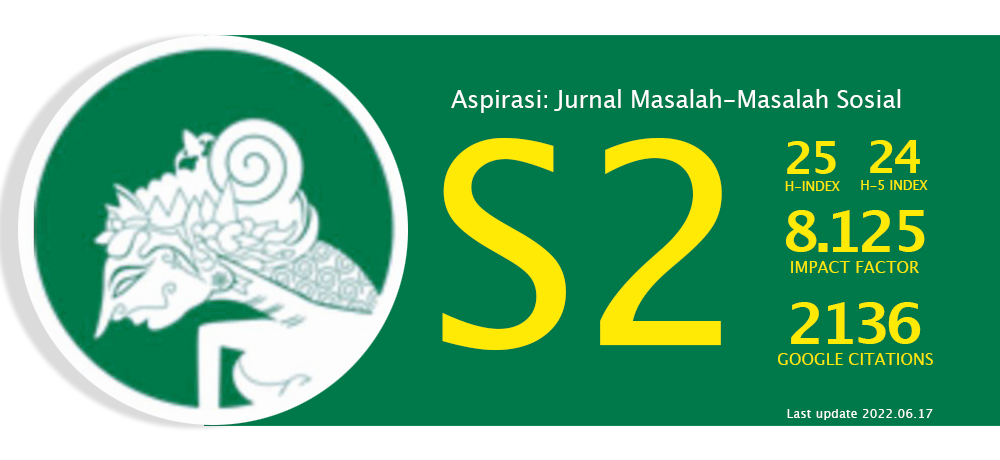Peran Kementerian/Lembaga Negara untuk Meningkatkan Daya Saing Kepariwisataan Indonesia
Abstract
state institution in increasing the competitiveness of Indonesian tourism in the global market. By using a scoring for each TTCI sub-pillar indicator, this study aims to map
the role of each ministry/state institution in the competitiveness of Indonesian tourism in the global market. This study resulted in recommendations for the Indonesian House of Representatives (DPR RI) through its supervisory function in encouraging ministries/state institutions to disseminate information to regional tourism stakeholders regarding how to view competitive and sustainable tourism development based on the TTCI indicator. The DPR RI also needs to slightly encourage the existing indicators to be included in the performance target indicators of the relevant ministries/state institutions. Primary data indicators also need to be considered by publishing development achievements to the public to harmonize government development achievements with public perceptions as recipients of these development outcomes. Thus, the synergy in achieving the competitiveness target can be materialized optimally.
Abstrak
Indikator daya saing kepariwisataan dunia yang dikenal dengan Travel and Tourism Competitiveness Index (TTCI) diterbitkan oleh World Economic Forum (WEF) sebagai tolok ukur daya saing pariwisata secara global. Peningkatan TTCI
merupakan salah satu target pembangunan jangka menengah Indonesia periode 2020–2024 sehingga penting untuk dapat mengidentifikasi sebaran peran dan kontribusi dari setiap kementerian/lembaga negara dalam meningkatkan daya saing kepariwisataan Indonesia di pasar global. Dengan menggunakan pembobotan pada setiap indikator subpilar TTCI, kajian ini bertujuan untuk memetakan peran setiap kementerian/lembaga negara dalam daya saing kepariwisataan Indonesia di pasar global. Kajian ini mengidentifikasi bahwa terdapat 17 mitra strategis Kementerian Pariwisata dan Ekonomi Kreatif dalam membentuk daya saing kepariwisataan. Kajian ini merekomendasikan kepada Dewan Perwakilan Rakyat Indonesia (DPR RI) melalui fungsi pengawasan untuk mendorong kementerian/lembaga agar melakukan sosialisasi kepada pemangku kepariwisataan daerah terkait bagaimana cara memandang pembangunan kepariwisataan yang berdaya saing dan berkelanjutan berbasis pada indikator TTCI. DPR RI juga perlu mendorong agar indikator-indikator yang ada masuk ke dalam capaian indikator sasaran kinerja kementerian/lembaga terkait. Penting juga bagi kementerian/lembaga untuk memperhatikan indikator data primer dengan melakukan publikasi capaian-capaian pembangunan pada publik guna menyelaraskan capaian pembangunan pemerintah dengan persepsi masyarakat sebagai penerima manfaat dari hasil pembangunan. Dengan demikian, maka sinergi dalam pencapaian target daya saing dapat terlaksana secara optimal.
Keywords
Full Text:
PDFReferences
Adam, L. (2016). Membangun daya saing tenaga kerja Indonesia melalui peningkatan produktivitas. Jurnal Kependudukan Indonesia, 11(2), 71–84. https://doi.org/10.14203/jki.v11i2.205
Algieri, B., Aquino, A., & Succurro, M. (2018). International competitive advantages in tourism: an eclectic view. Tourism Management Perspectives, 25(January 2018), 41–52. https://doi.org/10.1016/j.tmp.2017.11.003
Amalyah, R., Hamid, D., & Hakim, L. (2016). Peran stakeholder pariwisata dalam pengembangan pulau samalona sebagai destinasi wisata bahari. Jurnal Administrasi Bisnis, 37(1), 158–163. http://administrasibisnis.studentjournal.ub.ac.id/index.php/jab/article/view/1439
Andrades, L., & Dimanche, F. (2017, October). Destination competitiveness and tourism development in Russia: Issues and challenges. Tourism Management, 62, 360–376. https://doi.org/10.1016/j.tourman.2017.05.008
Antariksa, B. (2016). Kebijakan pembangunan kepariwisataan: pengembangan kepariwisataan yang berkelanjutan dan perlindungan kekayaan intelektual. Intrans Publishing.
Aribowo, H., Wirapraja, A., & Putra, Y. D. (2018). Implementasi kolaborasi model pentahelix dalam rangka mengembangkan potensi pariwisata di Jawa Timur serta meningkatkan perekonomian domestik. Jurnal Mebis (Manajemen dan Bisnis), 3(1), 31–38. https://doi.org/10.33005/mebis.v3i1.21
Blanke, J., & Chiesa, T. (2008). The travel and tourism competitiveness report 2008: Balancing economic development and environmental sustainability. World Economic Forum. http://citeseerx.ist.psu.edu/viewdoc/download?doi=10.1.1.225.7976&rep=rep1&type=pdf
Calderwood, L. U., & Soshkin, M. (2019). Travel & tourism competitiveness report 2019: Travel and tourism industry at a tipping point. World Economic Forum’s Platform for Shaping the Future of Mobility. http://www3.weforum.org/docs/WEF_TTCR_2019.pdf
Cîrstea, Ş. D. (2014). Travel & tourism competitiveness: A study of world’s top economic competitive countries. Procedia Economics and Finance, 14, 1273–1280. https://doi.org/10.1016/S2212-5671(14)00588-7
Croes, R., & Kubickova, M. (2013). From potential to ability to compete: Towards a performance-based tourism competitiveness index. Journal of Destination Marketing and Management, 2(3), 146–154. https://doi.org/10.1016/j.jdmm.2013.07.002
Croes, R., Ridderstaat, J., & Shapoval, V. (2020). Extending tourism competitiveness to human development. Annals of Tourism Research, 80(2020), 102825. https://doi.org/10.1016/j.annals.2019.102825
Crotti, R., & Misrahi, T. (2015). The travel & tourism competitiveness report 2015: Growth through shocks. World Economic Forum. https://www3.weforum.org/docs/TT15/WEF_Global_Travel&Tourism_Report_2015.pdf
Crotti, R., & Misrahi, T. (2017). The travel & tourism competitiveness report 2017: Paving The way for a more sustainable and inclusive future. World Economic Forum. http://www3.weforum.org/docs/WEF_TTCR_2017_web_0401.pdf
Dias, J. G. (2017). Environmental sustainability measurement in the Travel & Tourism Competitiveness Index: An empirical analysis of its reliability. Ecological Indicators, 73, 589–596. https://doi.org/10.1016/j.ecolind.2016.10.008
Fernández, J. A. S., Azevedo, P. S., Martín, J. M. M., & Martín, J. A. R. (2020). Determinants of Tourism Destination Competitiveness in the countries most visited by international tourists: Proposal of S Synthetic Index. Tourism Management Perspectives, 33, 1–13. https://doi.org/10.1016/j.tmp.2019.100582
Gabor, M. R., Conţiu, L. C., & Oltean, F. D. (2012). A comparative analysis regarding European Tourism competitiveness: Emerging versus developed markets. Procedia Economics and Finance, 3(12), 361–366. https://doi.org/10.1016/S2212-5671(12)00165-7
Kovačević, N. D., Kovačević, L., Stankov, U., Dragićević, V., & Miletić, A. (2018). Applying destination competitiveness model to strategic tourism development of small destinations: The case of South Banat District. Journal of Destination Marketing and Management, 8, 114–124. https://doi.org/10.1016/j.jdmm.2017.01.002
Kusumawardhani, Y. (2020). Kajian 14 pillar pada Travel And Tourism Competitiveness Index (TTCI) sebagai indikator daya saing pariwisata suatu negara. Tourism Scientific Journal, 6(1), 79–95. https://doi.org/10.32659/tsj.v6i1.129
Lopes, A. P. F., Muñoz, M. M., & Alarcón-Urbistondo, P. (2018). Regional tourism competitiveness using the PROMETHEE approach. Annals of Tourism Research, 73(November 20198), 1–13. https://doi.org/10.1016/j.annals.2018.07.003
Martínez, R. M., Galván, M. O., & Lafuente, A. M. G. (2014). Public policies and tourism marketing: An analysis of the competitiveness on tourism in Morelia, Mexico and Alcala de Henares, Spain. Procedia - Social and Behavioral Sciences, 148, 146–152. https://doi.org/10.1016/j.sbspro.2014.07.028
Maulana, A. (2019). Kajian perhitungan Global Gross Travel Propensity (GTP) dan Country Potential Generation Index (CPGI) 2016. Jurnal Pariwisata Pesona, 4(2), 139–148. https://doi.org/10.26905/jpp.v4i2.2594
Peraturan Presiden Nomor 18 Tahun 2020 tentang Rencana Pembangunan Jangka Menengah 2020–2024. (2020).
Undang-Undang Republik Indonesia Nomor 23 Tahun 1999 tentang Bank Indonesia. (1999).
DOI: https://doi.org/10.46807/aspirasi.v13i2.2916
Refbacks
- There are currently no refbacks.








